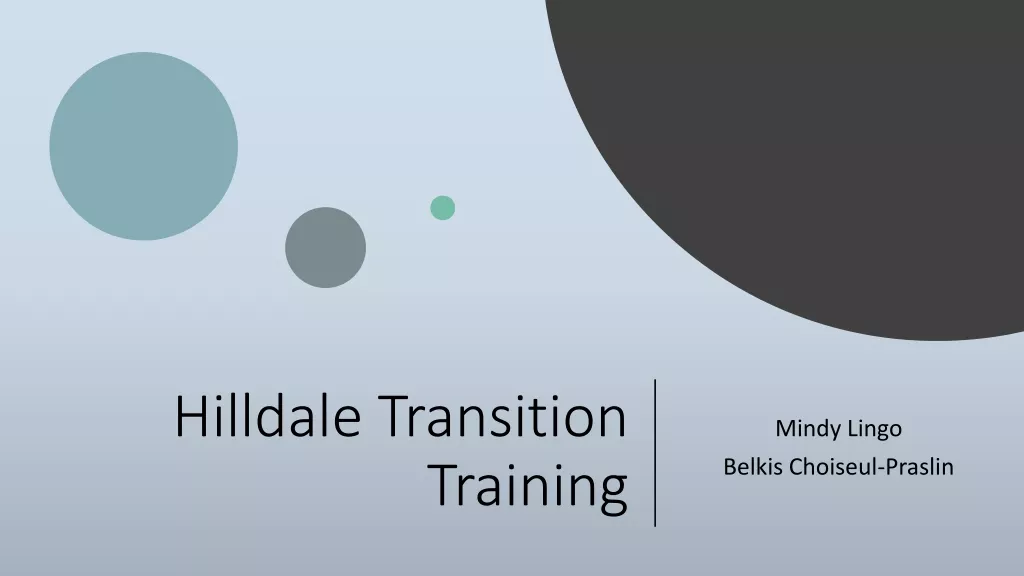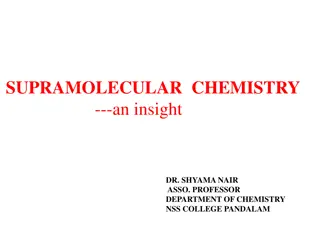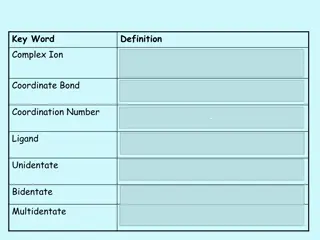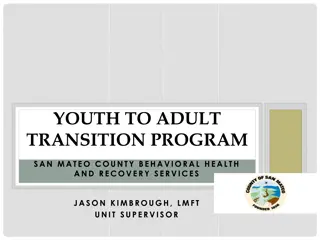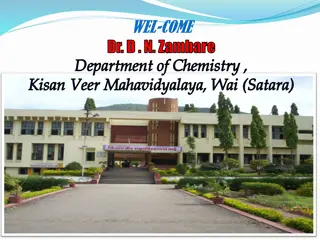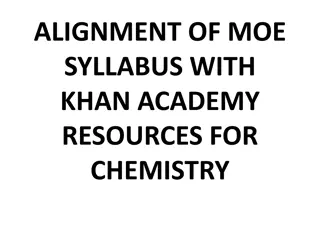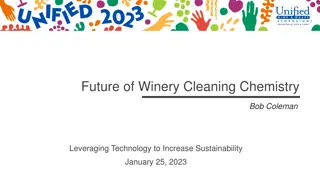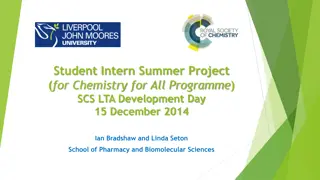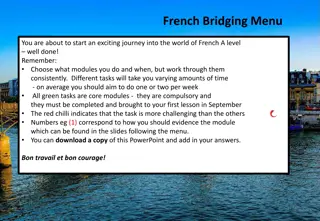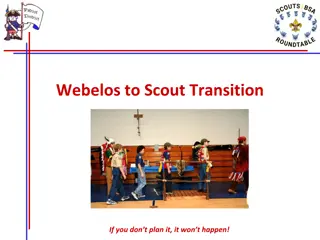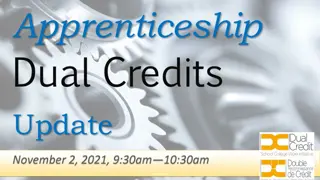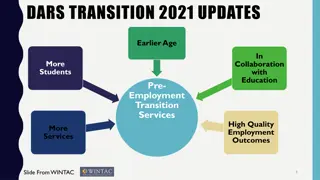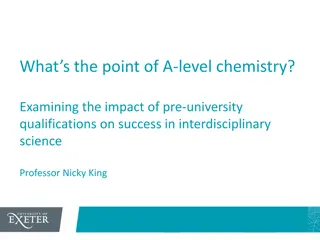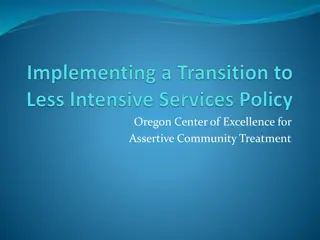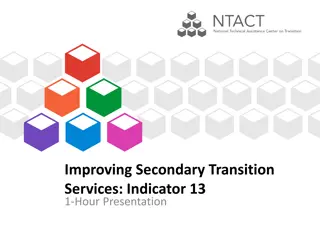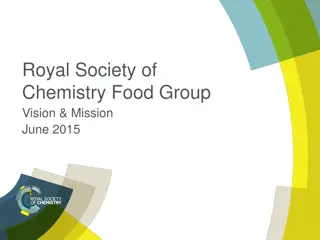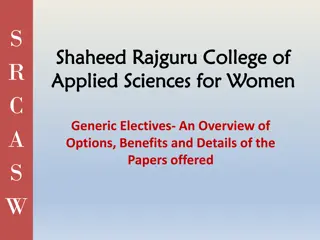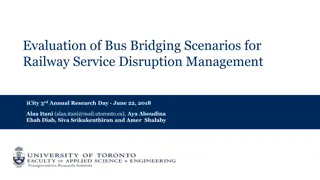A-Level Chemistry Bridging Unit Transition Guide
This booklet provides essential material to bridge the gap between GCSE and A-Level Chemistry. It includes self-reflection questions, interesting facts, and tips to prepare for the A-Level course.
Download Presentation

Please find below an Image/Link to download the presentation.
The content on the website is provided AS IS for your information and personal use only. It may not be sold, licensed, or shared on other websites without obtaining consent from the author.If you encounter any issues during the download, it is possible that the publisher has removed the file from their server.
You are allowed to download the files provided on this website for personal or commercial use, subject to the condition that they are used lawfully. All files are the property of their respective owners.
The content on the website is provided AS IS for your information and personal use only. It may not be sold, licensed, or shared on other websites without obtaining consent from the author.
E N D
Presentation Transcript
A-Level Chemistry Bridging Unit In this booklet you will find everything you need to successfully transition between GCSE and A-Level Chemistry! You should complete the sessions assigned during the summer holidays. This will make sure you start back in Year 12 in the best possible position. You should be completing around 1.5 hours per session. You should then bring this booklet and all associated work to your first Chemistry lesson in September. If you attended ALL of our bridging sessions in school, you can skip session 1 if you like as we covered this information during our sessions. Feel free to complete if you would like some more practice, however! We can t wait to see you in September to continue your Chemistry journey! Any questions at all, contact Miss Vaughan at: Email: evaughan@st-wilfrids.org
Did you know. If you pour a handful of salt into a full glass of water, the water level will actually go down rather than overflowing the glass. The only letter that doesn t appear on the periodic table is J. Although oxygen gas is colourless, the liquid and solid forms of oxygen are blue. The human body contains enough carbon to provide graphite for 9,000 pencils. Hydrofluoric acid is so corrosive that it will dissolve glass, but it is considered to be a weak acid. One bucket full of water contains more atoms than there are buckets of water in the Atlantic ocean. Bee stings are acidic, while wasp stings are alkaline. Water freezes faster when it is warm, not cold. Mars looks red due to the high levels of rust (iron oxide) on its surface. 20% of the world s oxygen is produced in the Amazon Rainforest. DNA is flame retardant. Scientists are using DNA to try and produce flame- retardant clothing. Vanadium Oxide is the only known substance which is in a conductor of electricity but not heat. Olympic gold medals are made of at least 95% silver. Uranus is a planet that is extremely rich in flammable gases like methane and hydrogen. None of these gases burn, however, as Uranus does not contain enough oxygen. The sun doesn t have any oxygen so how does it burn? Well it doesn t! The heat and light come from nuclear fusion reactions, not combustion reactions. The smell we recognise after a thunderstorm is the smell of ozone (O3). Lightening heats up the air to 50,000 degrees Celsius, which can cause some oxygen in the air to combine into ozone which we can smell. The hydrogen atoms that make up your body are 13.7 billion years old We can t reach absolute zero. It is a theoretical temperature. The closest we have come is the range of a billionth of 1K. Helium changes your voice as it is a less dense gas, so sound travels around 2-3 times faster through it. If you peed in space it would vaporise into a gas immediately due to the lack of air pressure. Lobsters have blue blood, as their version of haemoglobin, hemocyanin, has a copper atom at its centre, responsible for the blue colour. Metals don t have a smell. The smell we associate with them is due to a reaction where the metals decompose the oils present in our skin, making 1- octen-3-one, which is responsible for the smell.
Preparing Yourself Before we start looking at how to prepare ourselves for the content of A-Level Chemistry, it would be useful for us to use this extra time we have to prepare ourselves to be the best possible A-Level Chemistry students we can be! To do this I have put some self-reflection questions on this page that I would like you to complete. If you attended our bridging sessions in school then you will have already done these and don t need to do them again! We will discuss our ideas when we re back together in September. Self-reflection Questions 1. Which parts of GCSE Chemistry did you enjoy the most? 2. What did you find difficult in GCSE Chemistry? 3. Give three ways that you think you ensured you made maximum progress at GCSE Chemistry 4. Give five attributes that you think an A-Level Chemistry student must have 5. What do you envisage being your biggest challenge at A-Level? 6. What are you most excited for during the A-Level Chemistry course?
Session One I know how much you all loved the calculations part of GCSE Chemistry! We re going to spend some time this week recapping the calculations that come up again at A- Level. These include: Relative Atomic Mass and Relative Formula Mass Concentration Calculations using Moles Empirical and Molecular Formulae Some of the A-Level calculations include those from the Separate Chemistry course. This is an ideal time for those of you that did Combined Science to get up to speed. These calculations are: Atom Economy Percentage Yields Molar Volumes 1. Use the following resources to revise and brush up on the above calculations: Your GCSE revision guide https://www.bbc.co.uk/bitesize/guides/z2ty97h/revision/1 https://www.bbc.co.uk/bitesize/guides/zpk2srd/revision/1 https://www.bbc.co.uk/bitesize/guides/zg9rxfr/revision/1 https://www.bbc.co.uk/bitesize/guides/zwbyjty/revision/1 Pages 37-40 in your Head Start to A-Level Chemistry book https://www.youtube.com/watch?v=UQV9tLkQI3k Write a calculations summary sheet that includes key formulae that you need to learn off by heart. This will come in very useful in Year 12! Complete and self-assess the exam questions on the next couple of pages. 2. 3.
Calculations Exam Questions Q1. How many protons are there in 6.0 g of nitrogen gas? Avogadro constant, L = 6.022 1023 mol 1 A 1.3 1023 B 9.0 1023 C 1.8 1024 D 3.6 1024 (Total 1 mark) Q2. A solution of volume 500 cm3 contains 150 g of ammonia. What is the concentration, in mol dm 3, of ammonia in this solution? A 0.51 B 8.82 C 16.7 D 17.6 (Total 1 mark) Q3. What is the mass, in mg, of carbon formed when 3.0 10 3 mol of propene undergoes incomplete combustion? 2C3H6 + 3O2 6C + 6H2O 9.0 10 3 A 3.6 10 2 B 1.08 102 C 2.16 102 D (Total 1 mark) Q4.
Q4. What is the empirical formula of an oxide of nitrogen that contains 26% nitrogen by mass? NO2 A N2O3 B N2O5 C N4O5 D (Total 1 mark) Q5. Ethanol can be made from glucose by fermentation. C6H12O6 2C2H5OH + 2CO2 In an experiment, 268 g of ethanol (Mr = 46.0) were made from 1.44 kg of glucose (Mr = 180.0). What is the percentage yield? A 18.6% B 36.4% C 51.1% D 72.8% (Total 1 mark) Q6. Which sample of liquid has the greatest volume? A 500 mg of pentane (density = 0.63 g cm 3) B 650 mg of propan-1-ol (density = 0.80 g cm 3) C 1.20 g of dichloromethane (density = 1.33 g cm 3) D 1.30 g of trichloromethane (density = 1.48 g cm 3) (Total 1 mark) Q7. Q7. A gas cylinder contains 5.0 kg of propane. A gas cylinder contains 5.0 kg of propane. How many propane molecules are in the cylinder? How many propane molecules are in the cylinder? The Avogadro constant, L = 6.022 1023 mol 1 The Avogadro constant, L = 6.022 1023 mol 1 A 6.8 1022 B 7.2 1022 C 6.8 1025 D 7.2 1025 (Total 1 mark)
Mark schemes Q1. C [1] Q2. D [1] Q3. C [1] Q4. C [1] Q5. B [1] Q6. C [1] Q7. C [1]
Session Two Similarly to your GCSE course, you re A-Level Chemistry course contains required practicals that you must carry out. The first one you will carry out will be a Titration to find the concentration of an unknown substance. Separate Chemists will be familiar with titrations from Year 10. Combined scientists this is again a great opportunity to get caught up! Your task this week is to produce an Idiot s Guide to Titrations. The format you produce this in is entirely up to you, but it should include: The names of pieces of key equipment and what they are used for A general method to use during the practical Common mistakes or issues that people come up against, and how to make sure this doesn t happen to you Calculations that must be carried out on your results Potential sources of information https://www.bbc.co.uk/bitesize/guides/zg9rxfr/revision/3 https://www.youtube.com/watch?v=jnG9Ut--yUA https://www.youtube.com/watch?v=UAkibS8DOqY https://www.youtube.com/watch?v=UAkibS8DOqY https://www.youtube.com/watch?v=LsYXOa38OgE&list=PL xkbSWenXKXp3i8gRXvpM3FMC36yTe1U1 https://chemrevise.files.wordpress.com/2016/08/1-25- titrations.pdf
Session Three At GCSE we looked in-depth at Ionic, Metallic and Covalent bonding. We look at this in even more detail at A-Level. To prepare for this you should complete the task below. You could read ahead using your bridging book from Kindle, and any other online resources you can find and add some A-Level detail in! Particularly I would love it if you included some information on dative covalent bonds!
Further Reading Book Recommendations (note: these are just suggestions, we do not expect you to have read them all!) Periodic Tales: The Curious Lives of the Elements (Paperback) Hugh Aldersey-Williams ISBN-10: 0141041455 http://bit.ly/pixlchembook1 This book covers the chemical elements, where they come from and how they are used. There are loads of fascinating insights into uses for chemicals you would have never even thought about. The Science of Everyday Life: Why Teapots Dribble, Toast Burns and Light Bulbs Shine (Hardback) Marty Jopson ISBN-10: 1782434186 http://bit.ly/pixlchembook2 The title says it all really, lots of interesting stuff about the things around you home! Bad Science (Paperback) Ben Goldacre ISBN-10: 000728487X http://bit.ly/pixlchembook3 Here Ben Goldacre takes apart anyone who published bad / misleading or dodgy science this book will make you think about everything the advertising industry tries to sell you by making it sound sciency . Calculations in AS/A Level Chemistry (Paperback) Jim Clark ISBN-10: 0582411270 http://bit.ly/pixlchembook4 If you struggle with the calculations side of chemistry, this is the book for you. Covers all the possible calculations you are ever likely to come across. Brought to you by the same guy who wrote the excellent chemguide.co.uk website.
Something to Watch Videos to watch online (again, these are just suggestions, we do not expect you to have watched them all!) Rough science the Open University 34 episodes available Real scientists are stranded on an island and are given scientific problems to solve using only what they can find on the island. Great fun if you like to see how science is used in solving problems. There are six series in total http://bit.ly/pixlchemvid1a http://www.dailymotion.com/playlist/x2igjq_Rough-Science_rough-science-full- series/1#video=xxw6pr or http://bit.ly/pixlchemvid1b https://www.youtube.com/watch?v=lUoDWAt259I A thread of quicksilver The Open University A brilliant history of the most mysterious of elements mercury. This program shows you how a single substance led to empires and war, as well as showing you come of the cooler properties of mercury. http://bit.ly/pixlchemvid2 https://www.youtube.com/watch?v=t46lvTxHHTA 10 weird and wonderful chemical reactions 10 good demonstration reactions, can you work out the chemistry of . any of them? http://bit.ly/pixlchemvid3 https://www.youtube.com/watch?v=0Bt6RPP2ANI Chemistry in the Movies Dantes Peak 1997: Volcano disaster movie. Use the link to look at the Science of acids and how this links to the movie. http://www.open.edu/openlearn/science-maths- technology/science/chemistry/dantes-peak http://www.flickclip.com/flicks/dantespeak1.html http://www.flickclip.com/flicks/dantespeak5.html Fantastic 4 2005 &2015: Superhero movie Michio Kaku explains the real science behind fantastic four http://nerdist.com/michio-kaku-explains-the-real-science-behind-fantastic-four/ http://www.flickclip.com/flicks/fantastic4.html
Who to follow on Twitter Below is a list of people you might find it useful and interesting to follow on Twitter: @ProfBrianCox Particle Physics Professor @ASFC_CHEMISTRY Ashton Sixth Form College Chemistry who do great YouTube videos @newscientist Twitter account for the magazine @UKScienceguy The famous face behind the revision YouTube videos @BBCScienceNews @IFLScience Funny science content @royalsociety @NASA @TEDx watch TED events and streams from around the world @NatGeo @RoySocChem Royal Society of Chemistry @NCL_medresearch The Faculty of Medical Sciences at Newcastle University @ChemistryWorld Chemistry Magazine published by the Royal Society of Chemistry. @NewcastleMedSch Newcastle University Medical School @MaChemGuy Makes great A- Level Chemistry YouTube videos @TakeThatChem Science Fun @ChemistryALevel @ScienceMagazine cutting-edge research @compoundchem Great chemistry infographics @BillNye The Science Guy @neiltyson Astrophysicist


